An insider’s guide to taking your temperature.
The most-measured quantity on earth is time. That makes sense. However, did you know that the second most-measured quantity is temperature? Think of all the devices that monitor hot and cold in your life, from the ones that regulate your heating and cooling system and your car, to the ones in your kitchen appliances and your computer. And, of course, there is one of the most important pieces of medical equipment in your home—the clinical thermometer—which measures body temperature and is the subject of this story.
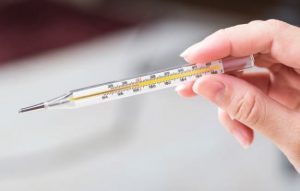 Interestingly, what all of the aforementioned measuring devices have in common is that they share a single ancestor, one that looked a lot like the old glass-and-mercury thermometer, which, not for nothing, should no longer be in your medicine cabinet (but probably still is). More on this in “Getting Rid of Mercury” on page 43.
Interestingly, what all of the aforementioned measuring devices have in common is that they share a single ancestor, one that looked a lot like the old glass-and-mercury thermometer, which, not for nothing, should no longer be in your medicine cabinet (but probably still is). More on this in “Getting Rid of Mercury” on page 43.
Taking your temperature (or someone else’s) doesn’t involve much in the way of experience or artistry. However, there are a few hard and fast rules that are easy to forget if you’re not feeling well. For example, if you’re taking your temperature orally, wait a good 15 to 30 minutes after eating or drinking to get an accurate reading. If you’ve taken a medication designed to lower a fever, like Tylenol, wait six hours before using a thermometer to ensure your numbers are correct. And if you take your temp under the armpit, remember it must touch skin and not clothing (a surprisingly common mistake).
“Normal” temperatures for an adult range between 97 and 99 degrees. The range is slightly broader for children—95.9 to 99.5—while the normal range for infants is a tick higher at 97.9 to 100.4. According to Cheryl Meyer, RN, CEN, Assistant Director of the Trinitas Emergency Department, an infant with a temperature above 100.4 should be seen right away by a medical professional. The same goes for children with a fever above 102 and an adult with a temperature north of 103. A low-grade fever lasting more than a few days is also worth a call to your physician.
What does a fever mean? It means your body is fighting an illness (such as a virus) or infection of some kind. Fevers are often accompanied by other symptoms—typically chills, headaches and body aches, but also more severe symptoms, including vomiting, diarrhea and convulsions. COVID-19 symptoms, as we all know by now, are often characterized by a dry cough, exhaustion and breathing difficulty. There are ways to check for a fever without a thermometer, but they are unlikely to be accurate, especially if you are feeling your own forehead.
What does a high temperature reading tell you?
“It is usually indicative of infection and/or sepsis,” says Meyer. “However, a high temperature also could reflect an exposure to heat—such as when a child is left in a car…or if someone is left exposed to the heat for a long time, due to a medical emergency or accident, and they can’t seek shelter. Whatever the cause, you need to seek immediate medical attention.”
What can an unusually low temperature tell you? Meyer says that it can be the result of exposure to the environment—“such as our homeless population or someone who maybe was confused and got lost in and was exposed to the cold.” Be aware that it also can be caused by sepsis and/or infection, she adds.
Thermometer Basics
Thermometers take a patient’s temperature in five different ways, and each has a name: Oral/Sub-Lingual (under the tongue), Axillary (under the armpit), Rectal (in the rectum), Tympanic (in the ear) and Temporal (on the forehead). There are two essential parts to any medical thermometer, the sensor and the means of converting the result into something readable. For glass or plastic thermometers, the sensor is that  little bulb located on the business end of the thermometer. For infrared thermometers, a pyrometric sensor gathers the data. Once a reading is complete, you get a number—either as a digital readout, or using those hashmarks on an old-school thermometer.
little bulb located on the business end of the thermometer. For infrared thermometers, a pyrometric sensor gathers the data. Once a reading is complete, you get a number—either as a digital readout, or using those hashmarks on an old-school thermometer.
Okay, let’s get this part out of the way. The most accurate temperature reading is the rectal one. It is still the method of choice for infants. And also animals. Most people find oral temperature-taking boring or unpleasant, but for adults and children capable of keeping the thermometer under the tongue, this is the method of choice. If a person is unconscious or coughing heavily, sub-lingual may not be the answer, even with fast-reading digital models. In these cases, medical professionals choose between the ear and the armpit. An axillary reading can take five-plus minutes to be accurate and, even at that, many doctors mentally add a degree.
Getting Rid of Mercury
 Do you have an old-school mercury and glass thermometer in your medicine cabinet? If so, be aware that it contains half a gram of elemental mercury. That’s not enough to kill you (or even seriously harm you) if you somehow swallowed it (the vapors from the mercury are actually far more harmful), but all the mercury adds up when people start throwing their old thermometers away by the tens of millions. To properly dispose of a mercury thermometer, place it inside a plastic container or glass jar, fill the container with something oil-absorbent (like cat litter or sand) and mark it “Contains Mercury” with a Sharpie. Your town or county will have a hazardous chemical drop-off site where you can dispose of it properly.
Do you have an old-school mercury and glass thermometer in your medicine cabinet? If so, be aware that it contains half a gram of elemental mercury. That’s not enough to kill you (or even seriously harm you) if you somehow swallowed it (the vapors from the mercury are actually far more harmful), but all the mercury adds up when people start throwing their old thermometers away by the tens of millions. To properly dispose of a mercury thermometer, place it inside a plastic container or glass jar, fill the container with something oil-absorbent (like cat litter or sand) and mark it “Contains Mercury” with a Sharpie. Your town or county will have a hazardous chemical drop-off site where you can dispose of it properly.
Temporal thermometers are simple to use and very accurate between 97 and 100. Which, if you’re curious, is how that random dude at the front of Trader Joe’s became, literally, a front-line worker last year. A similar device is now being used on wrists instead of foreheads. Recent studies have shown that it is 95% accurate in terms of fever-screening ability—the same or better than forehead readings. Wrist scanners work because the artery is very close to the surface of the skin.
The Road to 98.6
Most of us have been ingrained with the knowledge that the ideal human body temperature is 98.6 degrees. Did you ever wonder who decided this, and how? It was a German physician and psychiatrist named Carl Wunderlich in the 1860s. He averaged out over a million (mostly armpit) readings and determined that the temperature of healthy people fell between 97.3 and 99.5, with an average within that range of 98.6.
Medical professionals are quick to point out that your temperature is usually lower in the morning than in the afternoon, often by a degree or more, so there is no reason to be wed to 98.6, other than it has been drilled into our heads since childhood. Many believe the more accurate average number is between 97.5 and 97.9. Why the drop? In the century-plus since Wunderlich’s time, humans have gotten fatter and have lower metabolic rates. The less heat your body has to make to keep all its parts going, the lower your temperature will be.
 While we’re on the topic of history, it’s worth noting that the basic principles behind the thermometer were known in ancient Greece more than 2,500 years ago. However, the first device you’d think of as approaching a “modern” thermometer was pioneered by Santorio Santorio (right) at the University of Padua in the early 1600s. Galileo, who was on a first-name basis with the professor, is believed to have had some input—as did other scientists who were exchanging ideas in Venice at the time. Temperature-taking was all the rage in 17th century Europe, it seems. Santorio’s invention used the expansion of water, not mercury, to show changes in temperature and was called a thermoscope. It became a thermometer after a standardized scale was added. The first scale measured only eight different “degrees.”
While we’re on the topic of history, it’s worth noting that the basic principles behind the thermometer were known in ancient Greece more than 2,500 years ago. However, the first device you’d think of as approaching a “modern” thermometer was pioneered by Santorio Santorio (right) at the University of Padua in the early 1600s. Galileo, who was on a first-name basis with the professor, is believed to have had some input—as did other scientists who were exchanging ideas in Venice at the time. Temperature-taking was all the rage in 17th century Europe, it seems. Santorio’s invention used the expansion of water, not mercury, to show changes in temperature and was called a thermoscope. It became a thermometer after a standardized scale was added. The first scale measured only eight different “degrees.”
Over the next century, scientists tinkered with non-water liquids, including brandy. In 1701, Isaac Newton proposed that thermometers be standardized to measure the difference between the melting point of ice and the temperature of the human body, with 12 degrees separating the two measurements. In 1714, a Dutch inventor found mercury to be the most reliable and sensitive thermometer-filler. His name was Daniel Fahrenheit and he made a nice living manufacturing mercury thermometers. In 1742, a Swedish physicist proposed a new temperature scale, which used 100 to express the freezing point of water and 0 for the boiling point of water. His name was Anders Celsius (right), and his colleagues loved the idea…with one small tweak: They flipped the script, making 0 the cold end and 100 the hot end. Outside of the academic community, almost no one in America has the faintest idea how Celsius works, so don’t feel bad.
physicist proposed a new temperature scale, which used 100 to express the freezing point of water and 0 for the boiling point of water. His name was Anders Celsius (right), and his colleagues loved the idea…with one small tweak: They flipped the script, making 0 the cold end and 100 the hot end. Outside of the academic community, almost no one in America has the faintest idea how Celsius works, so don’t feel bad.
 The first doctor who stuck a thermometer into a person as part of his patient practice was Herman Boerhaave (left), a Dutch chemist and physician who founded the first European teaching hospital at the University of Leiden in the early 1700s. His patients were none too thrilled about the idea—it took up to a half-hour to obtain an accurate reading, so no matter the input, the process was tedious and unpleasant. And if you think that’s a long time, consider that it took 150 more years to cut the temperature-taking times down to five minutes.
The first doctor who stuck a thermometer into a person as part of his patient practice was Herman Boerhaave (left), a Dutch chemist and physician who founded the first European teaching hospital at the University of Leiden in the early 1700s. His patients were none too thrilled about the idea—it took up to a half-hour to obtain an accurate reading, so no matter the input, the process was tedious and unpleasant. And if you think that’s a long time, consider that it took 150 more years to cut the temperature-taking times down to five minutes.
That breakthrough came after years of tinkering by a British scientist named (I swear I am not making this up) Thomas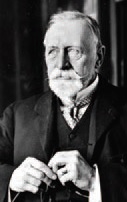 Allbutt (right). Just as thrilling was the fact that his clinical thermometer was only six inches long—half the (yikes) standard length during the early 1800s. Later in life, Allbutt was rewarded for his ingenuity by being appointed a Commissioner of Lunacy for England and Wales. Oh, and by the way, if you think wearing a mask and getting your forehead scanned is annoying, imagine waiting in line to get into Whole Foods only to encounter a 12-inch thermometer at the front door!
Allbutt (right). Just as thrilling was the fact that his clinical thermometer was only six inches long—half the (yikes) standard length during the early 1800s. Later in life, Allbutt was rewarded for his ingenuity by being appointed a Commissioner of Lunacy for England and Wales. Oh, and by the way, if you think wearing a mask and getting your forehead scanned is annoying, imagine waiting in line to get into Whole Foods only to encounter a 12-inch thermometer at the front door!
New Temp Tech
Thankfully, about 20 years ago, the temporal artery thermometer was unveiled by Exergen. A two-second forehead scan is all that’s needed to obtain an accurate temperature now. Dr. Frank Pompeii, who has a wall full of degrees from Harvard and MIT, developed this technology in the 1990s. Before forehead-scanning devices became affordable, you may recall that electronic ear thermometers—which measure blood temp with an infrared probe—were very popular. They came on the market in the late-1960s, courtesy of a German doctor named Theodor Benzinger, who emigrated to the U.S. after World War II and went to work for the Navy. He was actually experimenting with ways to measure brain temperature without the use of electrodes. Benzinger determined that the blood vessels coursing through the ear drum are shared with the hypothalamus, the part of the brain that regulates body temperature. The drawback to ear thermometers is that they can fail to detect a fever if a patient has significant wax build-up, or the probe records the temperature of the external ear canal and not the part containing the ear drum’s blood vessels.
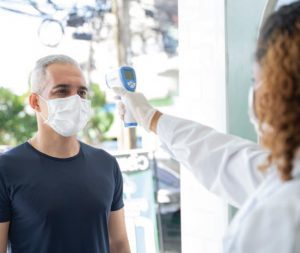 In conclusion, and to underscore an earlier point, the newer, safer methods for temperature-taking have made the mercury-and-glass thermometer entirely obsolete. Starting around 20 years ago, states began banning their sale and the National Institute of Standards and Technology stopped calibrating mercury thermometers a decade ago.
In conclusion, and to underscore an earlier point, the newer, safer methods for temperature-taking have made the mercury-and-glass thermometer entirely obsolete. Starting around 20 years ago, states began banning their sale and the National Institute of Standards and Technology stopped calibrating mercury thermometers a decade ago.
Although mercury is arguably the most beautiful and captivating of the elements, it also happens to be a neurotoxin that is almost impossible to clean up once it escapes its container. It’s bad stuff, so please say goodbye to your mercury thermometer if you haven’t already.
Editor’s Note: From the “Don’t Try This at Home” Department, the highest recorded human temperature was 115.7 degrees. Willie Jones of Atlanta set the record during a summer heat wave in 1980 and suffered no apparent ill effects. “Based on studies,” his doctor told reporters at a press conference, “Mr. Jones should not be sitting here next to me. He was as close to death as anyone gets.”
Seeing Red
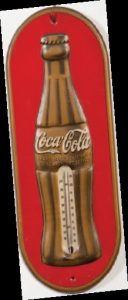
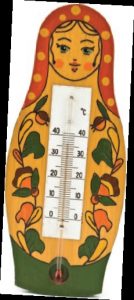 Mercury isn’t the only substance used in thermometers. Think of all the souvenir and advertising thermometers you’ve seen in your life. Some people actually collect them. The red stuff they contain is dyed alcohol or ethanol. It’s not as accurate as mercury and is not dangerous if the thermometer breaks. The substance is accurate up to 172 degrees, so it’s really only good for measuring air and body temperature.
Mercury isn’t the only substance used in thermometers. Think of all the souvenir and advertising thermometers you’ve seen in your life. Some people actually collect them. The red stuff they contain is dyed alcohol or ethanol. It’s not as accurate as mercury and is not dangerous if the thermometer breaks. The substance is accurate up to 172 degrees, so it’s really only good for measuring air and body temperature.









